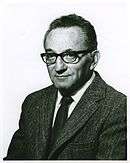Sol Spiegelman
| Sol Spiegelman | |
|---|---|
|
Sol Spiegelman | |
| Born |
December 14, 1914 Brooklyn, New York, U.S. |
| Died |
January 20, 1983 (aged 68) New York, New York, U.S. |
| Nationality | American |
| Fields | molecular biologist |
| Institutions | University of Illinois at Urbana-Champaign, Columbia University |
| Alma mater | City College of New York, Washington University in St. Louis |
| Known for | DNA structure, Cancer |
Sol Spiegelman (December 14, 1914 – January 20, 1983) was an American molecular biologist. He developed the technique of nucleic acid hybridization, which helped to lay the groundwork for advances in recombinant DNA technology.
Spiegelman was born and educated in New York City, and earned a bachelor's degree in mathematics from the City College of New York in 1939. He began his graduate studies at Columbia University in 1940, looking into cellular physiology. He completed his graduate studies at Washington University in St. Louis (1942–44) where he also lectured in physics and applied mathematics, receiving his doctorate there in 1944. After a year as a U.S. Public Health Service Fellow at the University of Minnesota, he joined the faculty of the University of Illinois and later became a professor of microbiology where he stayed for 20 years.
In 1962, he improved a technique that allowed the detection of specific RNA and DNA molecules in cells. Called nucleic acid hybridization originally developed by Rich and Davies in 1956,[1] it was the combination of viral DNA and viral RNA which helped to lay the groundwork for advances in recombinant DNA technology.[2]
In 1969 he became a professor of human genetics and development at the Columbia University College of Physicians and Surgeons as well as director of the Institute of Cancer Research in 1969. In 1975, he was named University Professor.
He investigated how cells form enzymes, DNA and RNA structures, virology and the molecular basis of cancer. He is credited with an experiment with self reproducing RNA structures called Spiegelman's Monster.
He received the Lasker Award in 1974 for his 1965 work on Qβ RNA. In 1981 he received the Antonio Feltrinelli International prize in Biology for his contributions to molecular biology. He published more than 350 papers.
Spiegelman worked on trying to establish that retroviruses cause human cancers. However, there were flaws in the theory.
Spiegelman died in 1983 of pancreatic cancer just before the cause of AIDS was identified as a human retrovirus.
See also
References
- ↑ Rich A; Davies DR (1956). "A new, 2-stranded helical structure, polyadenylic acid and polyuridylic acid". J. Am. Chem. Soc. 78:3548-9.
- ↑ Gillespie D; Spiegelman S (July 1965). "A quantitative assay for DNA-RNA hybrids with DNA immobilized on a membrane". J Mol Biol. 12 (3): 829–42. doi:10.1016/S0022-2836(65)80331-X. PMID 4955314.
External links
| Wikimedia Commons has media related to Sol Spiegelman. |
- Sol Spiegelman Papers (1929-1983) - National Library of Medicine finding aid
- The Sol Spiegelman Papers - Profiles in Science, National Library of Medicine
